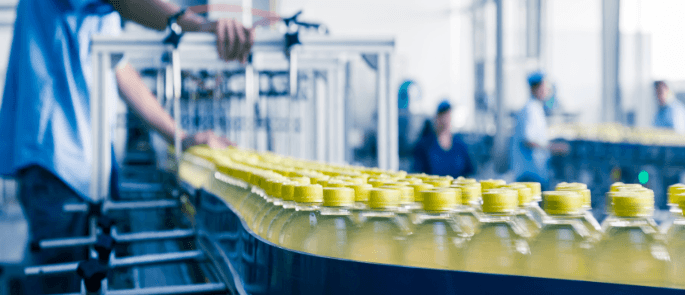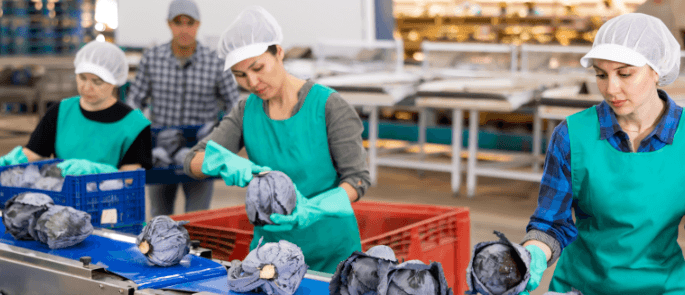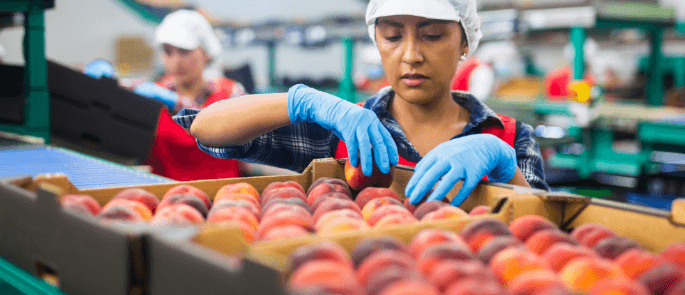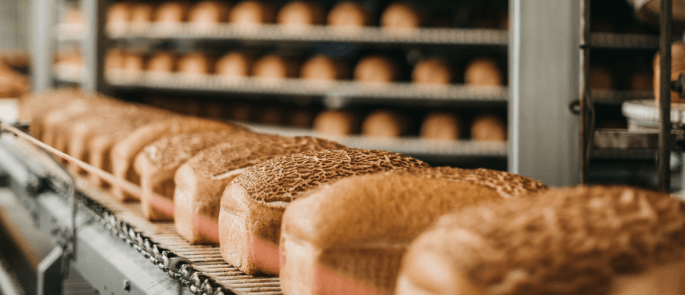Promoting a Food Safety Culture: Free Assessment Guide
Many businesses in the food and drink market already recognise the importance of having a mature food safety culture within the workplace, but some still have a way to go. A mature food safety culture is a tool which has the potential to promote good food safety practices throughout the business.
The topic of food safety culture has grown considerably over recent years, demonstrated by its continued inclusion in the latest release of the BRCGS standard (version 9). A mature food safety culture encourages employees to act and do the right thing when it comes to following food safety standards and procedures, even when they are not being observed.
This article will discuss what food safety culture is and why it is important in your food business. We will explore ways to measure food safety culture, and provide guidance to help you assess your existing workplace food safety culture, and what an action plan should include.

What is Food Safety Culture?
Food safety culture is a relatively new term in food safety. It is incredibly difficult to define and many organisations have proposed definitions to meet their respective requirements of food safety culture.
Dr Joanne Taylor developed the term food safety culture in the Food Safety Culture Excellence Model. Dr Taylor wrote that food safety culture is the “prevailing attitudes, values and practices related to food safety that are taught, directly and indirectly, to new employees”.
Since then, the Global Food Safety Initiative (GFSI) and BRCGS have coined similar definitions. The GFSI defines food safety culture as “shared values, beliefs and norms that affect mindset and behaviour toward food safety in, across and throughout an organisation.” Whilst the BRCGS offers its’ definition as being: “The attitudes, values, and/or beliefs which are prevalent at the site, relating to the importance of product safety, and the confidence in the product safety systems, processes and procedures used by the site.”
As you can see, there is much overlap between these definitions, but food safety culture is all of these things and more. It is composed of many specific aspects which are all equally important. Ultimately, food safety culture is exactly what you expect it to be – a culture of a business or workplace which emphasises all aspects of food safety and expects standards of safety to be of the highest level instinctively for all members of staff.

Why is a Food Safety Culture Important?
Anyone who works in a food-based business will know how important it is that all staff are properly trained in their role within the organisation. Whilst it is easy to display posters to remind staff to uphold best practice procedures, and it is a relatively simple task to monitor compliance in the form of due diligence checklists, one of the biggest hurdles that organisations face is getting their employees to always act correctly even when they are not being monitored.
Furthermore, the BRCGS Food Safety Issue 9 has expanded on food safety culture as a particular focus of attention. It is a requirement for senior management to demonstrate commitment and continual improvement to food safety culture within their organisation during an audit. The emphasis provides companies with the opportunity to have their food safety culture assessed, alongside their on-site food safety audit. To learn more about the BRCGS, take a look at our article Our Guide to Understanding BRCGS.
By promoting a food safety culture in their organisation, businesses can step up from providing training on food safety practices to staff, to seeing it in action from all employees at all times. This leads to benefits such as higher levels of compliance and high safety standards throughout the business, as well as having a more engaged workforce.
What are the benefits of a positive food safety culture?
Having an excellent food safety culture can help your business. By establishing a culture of values, and correct attitudes, norms and priorities regarding food safety, you can help all staff understand their role and impact within the organisation. Understanding this will foster employee engagement and empower staff at all levels to naturally commit to maintaining the highest standards of food safety.
Furthermore, a well-established food safety culture within any organisation helps to establish long-standing relationships with suppliers, and customer bases. And it helps toward building a reputational brand.
Whilst excellent scores and grades during an audit are desirable, during a crisis is where a positive food safety culture pays dividends. Any organisation that has an established food safety culture will have a strong and steady foundation on which to effectively manage any crisis with minimal disruption. Such a demonstration of competence instils confidence and gives reassurance to both customers and consumers alike. With the right food safety culture, companies can demonstrate their commitment to ethical practices.

What kind of characteristics does a well-developed food safety culture have?
An established food safety culture is also known as a mature, or well-developed food safety culture. A well-developed food safety culture is one that is working effectively, that is fundamental to daily working life for all employees in the organisation, and that seeks to continuously improve and operate sustainably. It will differ from business to business, and from site to site, but it should always be the ultimate aim.
To start with, a well-developed food safety culture must be promoted from the most senior levels of management to cascade effectively throughout the business. The management team must have a strong commitment to food safety and make it a priority, and senior staff members must demonstrate this through their everyday work.
Procedures must be in place to allow staff at all levels to demonstrate their contribution to the culture. And in an ideal world, the cascading effect will feed into other employees’ responsibilities across all levels and departments of the business, until it emerges as a grassroots culture. Alongside this, strong discouragement of unethical and unacceptable behaviour should be highlighted.
Why does a food safety culture matter to an organisation and its employees?
A mature food safety culture will help the organisation score highly and always be prepared for an unannounced audit. Emphasis on food safety will lead to fewer costly recalls and potentially brand-damaging food safety incidents. Essentially, unsafe behaviour is likely to result in unsafe food, and that can be an expensive outcome to manage – from product recalls, wastage, legal fees and damaged reputation. As such, this should be all the incentive an organisation needs to instil an excellent food safety culture.
Yet, in addition to these points, food safety culture also helps employees feel more engaged with their work. Knowing that they act in accordance with the organisation’s values and principles will align staff to be better workers and better ambassadors for the business. Food safety culture will therefore help improve staff engagement and retention. When a company has a mature food safety culture, it will inform everything about the business, from recruitment, GMP (Good Manufacturing Practice) and employee performance, to overall business success.

As outlined in the definitions above, culture is determined by the organisation’s values and the underlying norms and behaviours of existing employees. During the onboarding process with new employees, these values are communicated and passed along to new starters. It is therefore essential that new employees receive both excellent formal training on food safety practices, and that this training is supported by a culture of food safety among existing staff.
However, food safety culture goes beyond the training given to employees. It’s one thing to have employees that know what to do regarding food safety, yet it’s another to be confident that those employees will naturally follow correct procedures at all times, even when unobserved.
Developing a mature and well-established food safety culture encourages all within the business to hold food safety at the forefront, and to act at all times with its standard in mind. This will give you confidence that your business is operating in the best and safest way possible. Creating a mature and sustainable food safety culture is a difficult task to undertake, but it must be a priority for every business. Ultimately, food safety culture is born from an inherent sense of responsibility to provide safe food products to customers, consumers and communities worldwide. If you are responsible for food safety in your business, you may be interested in our other food safety management courses – Internal Auditing and HACCP online training course.
How Do You Measure Food Safety Culture?
Food safety itself is easily measurable and you can see it reflected in all manner of things in a business. It is evident in:
- Conformance to the HACCP plan.
- Compliance with food safety procedures.
- A good audit score.
- Reduced non-conformances during an audit.
- Conducting and evaluating root cause analysis.
It can also be seen in increasing sales, brand loyalty, low staff turnover and high staff engagement. To some extent, these can be useful in identifying your food safety culture – any business that does not score well in these areas will be unlikely to have a good food safety culture in operation. The level of maturity of your food safety culture will depend on how well-established it is, and how committed the senior leadership is to understanding it and supporting its implementation within the organisation.

However, there is not one single framework that a business should use to diagnose existing culture, measure it, and suggest ways to manage it. Most businesses will assess their individual needs and combine resources. For example, using the GFSI framework alongside other well-known standards, such as the BRCGS, and implementing their guidance to suit your own business. We will look at the GFSI framework in more detail later on in this article.
Measuring the food safety culture of an organisation can be very difficult. As we’ve discussed, food safety culture is often unseen – it is the actions that happen when staff aren’t being monitored that build culture. It is choosing the right way, not the easy way when no one is looking. Below, we’ll look at some ways in which you can think about measuring your food safety culture. Use the links below to look at each in more detail.

The ABC Model
The first step to measuring and internally auditing your food safety culture is identifying what you currently have. You need to take the time to diagnose the level of culture currently in existence as that will help guide you in areas to improve upon. One model that may help is the ABC model, incorporating the Antecedent (trigger), Behaviour and Consequence.
This is a useful tool to strengthen a business’s food safety culture as it allows you to see and manage behaviours within the workplace. Managing behaviours will reinforce and ensure the safety of the food and ultimately help inform the workplace culture.
An antecedent is something that comes before a behaviour and is required for an individual to understand what is expected and how to perform a behaviour. For example, policy, stated expectations, training, job aids, stimulus, circumstances and past experience are all antecedents. A consequence is something that follows the behaviour and is caused by the behaviour.
For example – new policies and procedures are being communicated to all employees on the correct handwashing technique. The antecedent is the training that is given, the expected outcomes and the policy itself, the behaviour is anything an individual does which is observable thereafter, and the consequence is based on what the employee does. There is a feedback loop in the behaviour, as what happened last time you behaved in a particular way will affect how you will behave the next time. Depending on the consequence, you will either sustain or change your behaviour.
Diagnosing the behaviours that are currently in existence in your business provides a starting point on which to build. However, you cannot confidently say that good results in these areas are indicative of an excellent culture 100% of the time – you cannot assume that observable behaviour leads to the same thing happening every time and even when unobserved.
Back to TopThe Culture Excellence Model
When it comes to measuring your food safety culture, there are several methodologies that you can apply. One widely recognised model is the Culture Excellence Model which encompasses the Four Ps – People, Purpose, Process and Proactivity.
People 
This first area includes looking at the following dimensions; empowerment, reinforcement, teamwork, training and communication. Thinking about your business, consider if people are empowered to take appropriate food safety actions. Are food safety practices reinforced throughout the business? Are the food safety and HACCP teams effective in their roles, and do all employees receive regular and effective food safety training and communications? Do all employees have training in food safety and do they understand the importance of it in their workplace?
Purpose 
This second area includes looking at the following dimensions: vision, values, targets, strategies and metrics. Thinking about your business, is there a clear long-term vision of the company, and does food safety feature heavily in it? Does food safety form part of the core values of the business? Can you clearly explain the strategic direction and plans for food safety, and are you able to set and manage food safety objectives? What are your goals for the future as an organisation with regard to food safety and what is your strategy for how you will achieve this?
Process 
This third area includes looking at the following dimensions: control, coordination, consistency, systems and premises. Thinking about your business, how effective are your food safety management controls? Is food safety coordinated across the company? Would you say there is a level of consistency and agreement in your food safety systems, and are these systems effective?
Proactivity 
The fourth area includes looking at the following dimensions: awareness, foresight, innovation, learning and investment. Thinking about your business, do you have a good awareness of external food safety influences and issues? Does the business take responsibility for foresight when it comes to future watching and food safety risks? Does the business proactively assess change, looking at innovation and investment in food safety, and does it encourage continuous learning, allowing the organisation to continue to learn about food safety? Can you identify and mitigate food safety risks in your workplace?
Recently, the Culture Excellence model was incorporated into the BRCGS as a voluntary module, offered alongside its BRC Food Safety Standard:
The site’s senior management shall define and maintain a clear plan for the development and continuing improvement of a food safety and quality culture. This shall include:
- Defined activities including all sections of the site that have an impact on product safety.
- An action plan indicating how the activities will be undertaken and measured, and the intended timescales.
- A review of the effectiveness of completed activities.
(BRCGS Issue 8 excerpt)
The GFSI Framework
Since the development of the Culture Excellence model, other organisations have been keen to contribute to the topic, not least the Global Food Safety Initiative (GFSI) which made a major contribution to this issue when, in November 2017, it published Food Safety Culture – A position paper from the Global Food Safety Initiative. This publication addresses food safety culture and how to implement a positive mindset in the organisation through various strategies. It has since formed the basis of how to develop a good food safety culture for many businesses.
The GFSI document identifies five organisational dimensions structured for Food Safety Culture, and we’ll take a look at these in detail below:
- Vision and mission.
- People.
- Consistency.
- Adaptability.
- Hazard and risk awareness.
Vision and Mission 
As the first of the five dimensions identified by the GFSI model, Vision and Mission is important because it communicates a business’s reason for existence, and explains how it translates this into expectations and specific messaging for its stakeholders.
Within this column, we have the key considerations of business structure, values and purpose, setting direction and expectations, leadership and messaging. When it comes to vision and mission, the company’s core values ought to be known and recognisable. They should form the basis of employee onboarding and remain visible to all employees throughout their time at the company. Meanwhile, leadership sets the direction and tone for a company’s food safety culture in ways that support, align and contribute to its overall vision and mission. Staff should be regularly reminded of the importance of food safety, whether they are recent hires or long-term staff members, part-time, full-time, contractors or externals. Explaining the why behind the fact will encourage employees to take ownership of food safety in their roles. All of these considerations are intrinsic to the success of the vision and mission, and thus – the food safety culture of the organisation.
‘The goal of all food safety messaging is to educate, inform and raise awareness among all new and existing employees of safe practices so they assume ownership of their role in ensuring consumer safety and brand protection.’ GFSI Paper.
People 
The people dimension refers to everybody who is part of the food industry – from farm workers, and those working in transportation, to packing, marketing, sales and beyond. It involves everyone involved in any part of the whole food chain. People are exposed to many processes throughout this chain which impacts directly upon food safety. Throughout the business, there should be a sense of personal responsibility, with a focus on competencies in food safety and providing everyone with an appropriate level of training so that they can use their skill set to uphold safe and effective food safety practices at work.
The company should work to promote people empowerment and encourage employees of all levels to have the power to lead or initiate positive change. Good communication is vital for ensuring that all employees understand the company’s food safety strategy, and it must be regular to keep it at the forefront of employees’ minds. Examples of communication methods include posters, briefings, training and mentoring, rewarding desired behaviour and consequences for undesired behaviour. It is also important that employees understand risk, and can communicate early indicators of risk to others, including potentially more senior members of staff, without fear of reprisal. As such, the company should also operate a clearly communicated and effective whistle-blowing policy.
One of the most important topics under the People dimension is learning. Ongoing learning through training and education are vital components of a food safety culture. Organisations must take the time to ascertain the most effective methods of training for different areas of the business. Training content should also be assessed and it must be relevant to each learner’s job competencies. Refresher training will further the environment of continuous learning, personal development and growth and it should be managed and given regularly.
The final part of this dimension is incentives, rewards and recognition. Studies of workplaces show that clear accountability and compliance foster commitment, empowerment and ownership. To achieve compliance with industry standards you can use feedback, recognition programmes, incentives and promotion or instigate disciplinary procedures for non-compliance. These tools when used effectively will reinforce good behaviours. Yet it is important to remember that all staff – even senior managers – are part of the people dimension and so they too are subject to the same strategies. Your business leaders must walk the walk if they talk the talk, and any that don’t are a liability to your organisation and threaten the food safety culture you are working hard to grow.
Consistency 
In the context of food safety culture, consistency is essential. Your food safety priorities must align with the requirements you put in place for the processes, the people and the resources you use to enable effective food safety and reinforce the food safety culture. The GFSI model identifies three major elements that support consistency – accountability, performance measurement and documentation. Giving employees clear accountability will allow them to take responsibility for their actions, and the consequences of their actions, in a food-safe environment.
To aid their decision-making, businesses should properly document their food safety expectations, plans and procedures. Documenting the business’s food safety approach is also extremely useful for onboarding new starters and contractors, and carrying out effective refresher training for existing staff.
Adaptability 
The fourth dimension of the GFSI model gives us adaptability. For a business to develop a food safety culture, evolution is essential. We know how continuous improvement is a necessary goal for food safety culture, and yet this cannot happen without an adaptable business. Therefore, a business needs to cultivate a culture of adaptability within its food safety culture to respond to changing influences.
The areas identified under adaptability are:
- Food safety expectations.
- Agility.
- Change, crisis management and problem-solving.
Once food safety expectations and direction are clear, the business is in a position to assess its current food safety culture against those expectations. In the context of food safety, agility is defined as the ability to think and assess opportunities and/or threats to draw conclusions and adjust strategy quickly. How much and how quickly can the company’s current business structure and processes be adjusted if necessary? Answering those questions for your own business will help show you how adaptable it is. A business needs to be able to adapt to change as necessary, have good crisis management procedures in place and be able to implement effective problem-solving.
Hazard and Risk Awareness 
The fifth and final dimension of the GFSI framework is hazard and risk awareness. To cultivate a well-developed food safety culture, all employees must know how potential hazards and risks may affect the business. Therefore, the business must communicate ‘why we do things’ to promote trust in procedures and processes that the right decisions are being made throughout the business. Education and training can help here by creating a sense of shared responsibility and helping to engage employees at all levels.
The three sections in this dimension are:
- Foundational hazard information and education.
- Employee engagement.
- Verifying hazard and risk awareness.
All employees need a basic overview of hazards to recognise the responsibility that comes with being in an industry in which the products are consumed. Everyone has a role, and recognising potential hazards is as important at the senior executive level as it is for line workers. Everyone should, therefore, be trained in the hazards and risks specific to their role.
There are several tools businesses can use to do this, such as carrying out announced and unannounced audits, reviewing near misses and observing staff behaviour. Review tools can be used to show a job well done, as well as highlight areas for improvement.
When it comes to hazard and risk awareness in your food safety culture, employee engagement is a huge resource available to you. Do not underestimate it, but nurture its growth. Communicating food safety news from the CEO level demonstrates top-down engagement when matched with financial and people investment, which can be impactful to employees. Couple this with improving awareness and an understanding of issues across the industry for grassroots engagement, and you can inspire trust and belief from all employees in the food safety system. And we know that engaged employees will be more invested in contributing to, and supporting, the food safety culture.

Free Food Safety Culture Assessment Guide
The UK has some of the most respected and comprehensive food safety laws in the world. This is down to the continued emphasis on food safety and HACCP for everyone who is involved in the supply of food to consumers, and the adoption of additional global industry standards. Yet, to continue to be world leaders, we must pay attention to the food safety cultures within our businesses.
The cultural standards within a business ensure everyday food safety protocols are upheld. They emerge through shared experiences and conversation, and they become intrinsic within the business through reinforced values, beliefs and actions.
Below, we have devised a list of questions for you to use in your business to help you assess your food safety culture. Once you have evaluated the strengths and weaknesses of each site and department in the business, you should have a better understanding of the level of the existing food safety culture.
Once you have assessed the food safety culture in your workplace, you need to implement an action plan for the development and continuous improvement of your food safety culture. This plan should be specific to your organisation, include activities for all employees in areas of the business, and effectively address the areas for improvement.
Action Plan
Your action plan may encompass different activities based on your assessment of your existing food safety culture, but, as a minimum, you should look to improve upon the following areas:
- Clear and open communication on product safety.
- Training.
- Feedback from employees.
- Behaviour changes required to improve product safety processes.
- Performance measurement on product safety, authenticity, legality and quality-related activities.
Your action plan should include how the activities will be carried out and measured. They should have a timescale, and a review of effectiveness after completion and the plan should be reviewed and updated at least once a year.
Employees need to actively and independently choose to do the right thing, regardless of observation. Still, even well-intentioned employees can struggle if they cannot access the proper tools, or the facility’s design and equipment make doing the right thing extremely difficult or time-consuming. Creating a mature culture is about expressing, nurturing and ultimately demonstrating desired attitudes and behaviours. Therefore, it makes training, communication, motivation and empowerment critical to the success of your business.
We hope this article has been informative and gives you key takeaways for your workplace so that you can develop your food safety culture. For more information on our training, please get in touch with our sales team – email – phone – who will be happy to discuss your training needs.
Further Resources:
- Introduction to Internal Auditing and Management Training
- Cyber Security in Food & Drink Manufacturing: BRCGS Standards
- Preventative Maintenance in the Food Industry
- Food Product Recall Procedure Template – Free Download
- What Does the BRCGS Grading System Mean?
- Whistleblowing on Food Crime – Do You Know Your Rights?
- Is There a Difference Between Food Hygiene and Food Safety?
- Good Manufacturing Practice Quiz
- Food Safety Awareness Quiz
- The Importance of Food Hygiene Training
- What is ISO 22000 – Food Safety Management?











